Urbana: Review of a True Transport Bike
A month ago, I received a bicycle from the Canadian manufacturer Urbana, to test ride and review. When the offer was initially made, I visited Urbana's website and was both confused and intrigued. Did they not see that I liked classic bicycles and not modern monstrosities? Did they realise the risk they were taking asking me to review this thing? Still, even then I was aware that this wasn't some generic comfort bike, but a unique design with a distinct look and unusual geometry. The manufacturer insisted that I'd like it once I tried it, and my curiosity was piqued.
If you've been reading this blog for the past month, you know the result: I ended up riding the Urbana far more than I had intended... to the annoyance of some readers who found it not sufficiently "lovely" to grace this website. But to those readers I say: Come on, open your mind. Though not "pretty" in the classic sense, the Urbana is aesthetically harmonious, well-designed and comfortable - which in my book is lovely indeed. The neon yellow was an accidental choice on my part: It was described as "olive" and looked army green on the website. But everything else about this bike I like. In fact, had I gotten it in black I would have had a problem parting with it - so perhaps the neon colour is a blessing in disguise.
So, what kind of bike is the Urbana? Technically speaking, it is a hybrid between a mountain bike, a BMX bike, and a Dutch transport bike. The mountain bike legacy comes from the downhill MTB designer Jerome Roy, in the form of reinforced frame and fork construction with wide 26" tires. The BMX attribute is in the handlebar setup and in the squat stature.
The Dutch aspect is in the relaxed angles, deep U-frame, fenders, and heavy-duty rear rack. It may seem like a mish-mash of incompatible styles, but it all comes together harmoniously - and, to my eye, adorably in a "friendly little forest troll" kind of way.
The sitting position itself feels Dutch, in the sense that the seat tube is relaxed (I would guess 70° or less), and I could attain nearly full leg extension while still being able to touch the ground with a toe.
At the same time, the low BMX handlebars place the rider in a considerably more forward-leaning position, than would a Dutch bike. The threadless stem allows to easily alter the positioning of the handlebars - leaning them toward or away from the rider, depending on preferences and the person's height. I had my bars set pretty much straight and found them comfortable.
This picture shows the relaxed geometry and long wheelbase of the bike fairly accurately, as well as the saddle-handlebars positioning. The frame of the Urbana is welded aluminum, executed in a manner that I would describe as industrial. Some readers have mentioned that the bike reminds them of "bikeshare" bicycles, but any visual similarity is superficial. The Urbana is constructed differently and handles differently. It is a bike meant to haul serious weight and to withstand the roughest terrain, which bike-share machines are not.
The letters carved into the frame are part of a security code for registering the bicycle (the second part of the code is located elsewhere). Urbana has an interesting system for registering and securing these bicycles that makes stealing them an unwise move.
Of course, one of the main defining features of the Urbana are its 26" x 2.6" Niddepoule "Sidewalk" balloon tires with reflective sidewalls. They are extremely wide, extremely cushy, and roll fairly fast. I have tried most good modern fat tires at this point, and in terms of handling these feel similar to the 26" Schwalbe Fat Franks - only wider. Potholes are not an issue.
Reviewers of the Urbana tend to delight in how easy and fun it is to hop curbs with the tires, and of course there is that. But I feel like stressing this aspect almost trivialises them. The tires are genuinely useful on bad roads. There is no road shock, none at all - which is a big deal for those who find going over potholes painful. I have rolled over what I would otherwise have considered obstacles on the road and swerved to avoid. And yes, I have gone up on curbs - just not on camera.
For gearing, I asked for the 3-speed option - which came with a Sturmey Archer hub. The hub worked flawlessly and was more than sufficient for me. The gearing felt similar to that on my Gazelle - I stayed mostly in second gear. Notice how the hub is connected to the (lack of?) rear dropouts. This frame construction is so different from what I am used to, that I do not even know how to describe this.
The SA twist shifter has a rainbow-esque look to it that I think suits the bike well. Not a whole lot of grip space next to the shifter, but more than on some other bikes I have tried. Interestingly, my hands did not hurt in the straight-in-front position these bars put me in, whereas usually I find this position unbearable as a result of nerve damage in my hands. It must be not just the hand position that bothers me, but the combination of it plus road shock. Since I experienced absolutely no road shock on this bike, the position alone did not cause discomfort. At least that is my theory as to how I was able to ride this bike, but not any other bike with the same style of handlebars.
Overall, the components used on the Urbana are pretty good - from the Cane Creek headset to the SKS fenders and chainguard. There are no flimsy, generic parts; all is solid. The Co-Habitant doesn't love the V-brakes they used, but otherwise he agrees. I thought the V-brakes were fine, though they are generally not my favourite brake type simply because they are too strong and don't modulate well. The Urbana stopped too well, and I had to be careful with that.
Notably, the Urbana is not equipped with a lighting system, which I see as its one major flaw. A dynamo lighting option would make it a fully equipped urban utility bike.
The proprietary saddle is tightly sprung and mildly padded vinyl. I found it quite comfortable for rides under 5 miles and felt no desire to change it. The Co-Habitant didn't like it, but I think that's because he is quite a bit heavier than I am and his weight made the springs over-active.
Last, but not least, there is what Urbana calls the Reinforced Rack (RNR). It looks fairly inconspicuous and normal as far as racks go, but is designed to withstand 160lb of dynamic weight. This includes anything from furniture, to squirming children, to - well, me.
The above was a fairly easy and normal arrangement for me to set up on the Urbana, and I wrote about it in detail here. I did not feel the weight shifting around or slowing me down while I was cycling. My Gazelle is pretty good at carrying loads as well, but not this good.
Aside from the generous weight rating, it also helps that attaching stuff to the RNR rack is easier than to any other rack I've owned. It's a ridiculously simple design that anyone could have thought of... but didn't. Each side of the rack's platform has a carved-out section with bolts poking out undearneath, making it possible to attach virtually any bag to the rack by wrapping the handles around the bolts.
The utility and freedom afforded by this ridiculously simple design is just amazing: No need for dedicated panniers.
Of course, if you do with to carry panniers, it's not a problem: The rack's tubing will accommodate almost any attachment system (with the exception of fixed 3-hook systems - which I believe only Fastrider uses). So the cyclist is really given functional freedom here. Panniers? Fine. No panniers? Also fine. The rack also has a handy built-in notch for bungee cord attachment at the bottom, which you can see here.
With its easy-to-load rack, and the durability that allowed me to keep it locked up outdoors 24/7, I was soon using the Urbana all the time for transportation - instead of my own bikes. Before I knew it, the Co-Habitant was using it too and you can read about us sharing the bike here. All this was in no way part of my agreement with Urbana, but entirely a product of how convenient the darn bike was to use. In the end, we end up using what's most convenient - simple as that.
The weight of the Urbana as I had it set up was roughly 42lb. There is one particular section on the seat tube by which it is very easy to pick the bike up, making the weight totally manageable. To pick it up any other way is uncomfortable. But best of all, is to park it outdoors. I kept it locked up in the back of the house for the entire month it was in my possession, and it weathered this just fine.
The ride quality feels more than anything like that of a good mountain bike... fitted with unusually fat, fast tires. Maybe because I rode a mountain bike in high school, the experience of riding the Urbana made me feel young and "bad-ass" again, which I enjoyed. Gosh, if someone gave me this bike when I was 16 years old and riding this, I would have been in heaven! Aside from the fun ride, this is probably the most stable bike I have tried thus far, all things considered. The responsiveness is decent, but obviously not roadish. Maybe half way between a mountain bike and Dutch bike. Acceleration is surprisingly good, and going uphill was similar to my Gazelle (i.e. good enough for my terrain). If you have ever tried a Retrovelo, its ride quality comes the closest to the Urbana than anything else I've tried - save for the posture and hand positioning.
Co-Habitant on the Urbana, with grocery bags.
Our neighbour Somervillain on the Urbana, riding no hands.
And the two of us together again. Can't say that I particularly enjoy riding on the rear rack (I like to pedal, not to be carted around), but it is definitely doable and the bike remains stable. We went to the grocery store this way once when we didn't feel like taking separate bikes, and it was fine. I screamed when he tried to hop a curb with me on the bike, but you can hardly blame me for that.
Overall, I do prefer the ride quality of traditional, upright loop-frame bicycles to the Urbana, simply because of the more comfortable hand positioning and the upright posture. Over long distances, I begin to find the MTB posture tiring - whereas on my traditional upright bicycles I can keep going for 30 miles. However, the utility and convenience of the Urbana made me prefer it for short-distance trips - especially when carrying anything of significance on the bike. Had the bike been equipped with lighting, its utility would have been truly remarkable, but the lack of lights made it only usable during daylight hours.
The US retail price of the Urbana will be around $1,000-1,370 - depending on how it is equipped. I suspect that the market will find that price range too expensive for this particular bike, but I could be wrong. Would I buy it for myself? Possibly - especially as a winter bike and dedicated "cargo chariot" that I would share with the Co-Habitant. I would get it in black, and I would want them to knock several hundred off the price. That is my honest feedback.
More than anything, the Urbana challenged my priorities - an experience that will have a long-lasting effect on my design sensibilities. I appreciate the opportunity to review this product and wish Urbana the best of luck.
So, what kind of bike is the Urbana? Technically speaking, it is a hybrid between a mountain bike, a BMX bike, and a Dutch transport bike. The mountain bike legacy comes from the downhill MTB designer Jerome Roy, in the form of reinforced frame and fork construction with wide 26" tires. The BMX attribute is in the handlebar setup and in the squat stature.
The sitting position itself feels Dutch, in the sense that the seat tube is relaxed (I would guess 70° or less), and I could attain nearly full leg extension while still being able to touch the ground with a toe.
At the same time, the low BMX handlebars place the rider in a considerably more forward-leaning position, than would a Dutch bike. The threadless stem allows to easily alter the positioning of the handlebars - leaning them toward or away from the rider, depending on preferences and the person's height. I had my bars set pretty much straight and found them comfortable.
This picture shows the relaxed geometry and long wheelbase of the bike fairly accurately, as well as the saddle-handlebars positioning. The frame of the Urbana is welded aluminum, executed in a manner that I would describe as industrial. Some readers have mentioned that the bike reminds them of "bikeshare" bicycles, but any visual similarity is superficial. The Urbana is constructed differently and handles differently. It is a bike meant to haul serious weight and to withstand the roughest terrain, which bike-share machines are not.
The letters carved into the frame are part of a security code for registering the bicycle (the second part of the code is located elsewhere). Urbana has an interesting system for registering and securing these bicycles that makes stealing them an unwise move.
Of course, one of the main defining features of the Urbana are its 26" x 2.6" Niddepoule "Sidewalk" balloon tires with reflective sidewalls. They are extremely wide, extremely cushy, and roll fairly fast. I have tried most good modern fat tires at this point, and in terms of handling these feel similar to the 26" Schwalbe Fat Franks - only wider. Potholes are not an issue.
Reviewers of the Urbana tend to delight in how easy and fun it is to hop curbs with the tires, and of course there is that. But I feel like stressing this aspect almost trivialises them. The tires are genuinely useful on bad roads. There is no road shock, none at all - which is a big deal for those who find going over potholes painful. I have rolled over what I would otherwise have considered obstacles on the road and swerved to avoid. And yes, I have gone up on curbs - just not on camera.
Urbana bicycles are semi-customisable, and I requested fenders. They use SKS fenders, which provide good coverage.
Some have complained that the front fender is too short - but while visually that is true, I did not find that I was sprayed with water from the front tire when cycling in the rain. We did find it difficult to set up the V-brakes in a way that did not interfere with the front fender. If you opt for the fenders, consider choosing disk brakes instead of the V-brakes.
The SA twist shifter has a rainbow-esque look to it that I think suits the bike well. Not a whole lot of grip space next to the shifter, but more than on some other bikes I have tried. Interestingly, my hands did not hurt in the straight-in-front position these bars put me in, whereas usually I find this position unbearable as a result of nerve damage in my hands. It must be not just the hand position that bothers me, but the combination of it plus road shock. Since I experienced absolutely no road shock on this bike, the position alone did not cause discomfort. At least that is my theory as to how I was able to ride this bike, but not any other bike with the same style of handlebars.
Overall, the components used on the Urbana are pretty good - from the Cane Creek headset to the SKS fenders and chainguard. There are no flimsy, generic parts; all is solid. The Co-Habitant doesn't love the V-brakes they used, but otherwise he agrees. I thought the V-brakes were fine, though they are generally not my favourite brake type simply because they are too strong and don't modulate well. The Urbana stopped too well, and I had to be careful with that.
Notably, the Urbana is not equipped with a lighting system, which I see as its one major flaw. A dynamo lighting option would make it a fully equipped urban utility bike.
The proprietary saddle is tightly sprung and mildly padded vinyl. I found it quite comfortable for rides under 5 miles and felt no desire to change it. The Co-Habitant didn't like it, but I think that's because he is quite a bit heavier than I am and his weight made the springs over-active.
Last, but not least, there is what Urbana calls the Reinforced Rack (RNR). It looks fairly inconspicuous and normal as far as racks go, but is designed to withstand 160lb of dynamic weight. This includes anything from furniture, to squirming children, to - well, me.
The above was a fairly easy and normal arrangement for me to set up on the Urbana, and I wrote about it in detail here. I did not feel the weight shifting around or slowing me down while I was cycling. My Gazelle is pretty good at carrying loads as well, but not this good.
Aside from the generous weight rating, it also helps that attaching stuff to the RNR rack is easier than to any other rack I've owned. It's a ridiculously simple design that anyone could have thought of... but didn't. Each side of the rack's platform has a carved-out section with bolts poking out undearneath, making it possible to attach virtually any bag to the rack by wrapping the handles around the bolts.
The utility and freedom afforded by this ridiculously simple design is just amazing: No need for dedicated panniers.
Of course, if you do with to carry panniers, it's not a problem: The rack's tubing will accommodate almost any attachment system (with the exception of fixed 3-hook systems - which I believe only Fastrider uses). So the cyclist is really given functional freedom here. Panniers? Fine. No panniers? Also fine. The rack also has a handy built-in notch for bungee cord attachment at the bottom, which you can see here.
With its easy-to-load rack, and the durability that allowed me to keep it locked up outdoors 24/7, I was soon using the Urbana all the time for transportation - instead of my own bikes. Before I knew it, the Co-Habitant was using it too and you can read about us sharing the bike here. All this was in no way part of my agreement with Urbana, but entirely a product of how convenient the darn bike was to use. In the end, we end up using what's most convenient - simple as that.
The weight of the Urbana as I had it set up was roughly 42lb. There is one particular section on the seat tube by which it is very easy to pick the bike up, making the weight totally manageable. To pick it up any other way is uncomfortable. But best of all, is to park it outdoors. I kept it locked up in the back of the house for the entire month it was in my possession, and it weathered this just fine.
The ride quality feels more than anything like that of a good mountain bike... fitted with unusually fat, fast tires. Maybe because I rode a mountain bike in high school, the experience of riding the Urbana made me feel young and "bad-ass" again, which I enjoyed. Gosh, if someone gave me this bike when I was 16 years old and riding this, I would have been in heaven! Aside from the fun ride, this is probably the most stable bike I have tried thus far, all things considered. The responsiveness is decent, but obviously not roadish. Maybe half way between a mountain bike and Dutch bike. Acceleration is surprisingly good, and going uphill was similar to my Gazelle (i.e. good enough for my terrain). If you have ever tried a Retrovelo, its ride quality comes the closest to the Urbana than anything else I've tried - save for the posture and hand positioning.
Co-Habitant on the Urbana, with grocery bags.
Our neighbour Somervillain on the Urbana, riding no hands.
And the two of us together again. Can't say that I particularly enjoy riding on the rear rack (I like to pedal, not to be carted around), but it is definitely doable and the bike remains stable. We went to the grocery store this way once when we didn't feel like taking separate bikes, and it was fine. I screamed when he tried to hop a curb with me on the bike, but you can hardly blame me for that.
Overall, I do prefer the ride quality of traditional, upright loop-frame bicycles to the Urbana, simply because of the more comfortable hand positioning and the upright posture. Over long distances, I begin to find the MTB posture tiring - whereas on my traditional upright bicycles I can keep going for 30 miles. However, the utility and convenience of the Urbana made me prefer it for short-distance trips - especially when carrying anything of significance on the bike. Had the bike been equipped with lighting, its utility would have been truly remarkable, but the lack of lights made it only usable during daylight hours.
The US retail price of the Urbana will be around $1,000-1,370 - depending on how it is equipped. I suspect that the market will find that price range too expensive for this particular bike, but I could be wrong. Would I buy it for myself? Possibly - especially as a winter bike and dedicated "cargo chariot" that I would share with the Co-Habitant. I would get it in black, and I would want them to knock several hundred off the price. That is my honest feedback.
More than anything, the Urbana challenged my priorities - an experience that will have a long-lasting effect on my design sensibilities. I appreciate the opportunity to review this product and wish Urbana the best of luck.



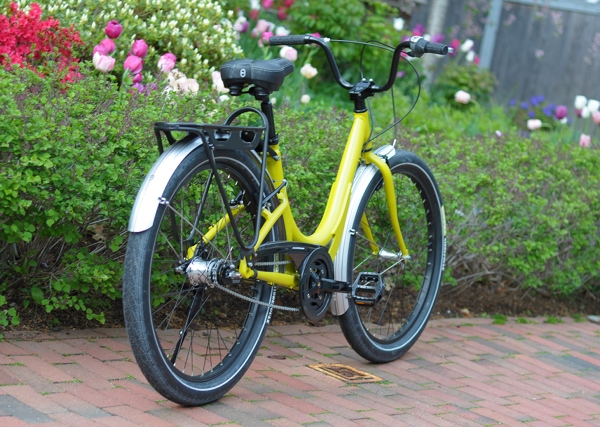

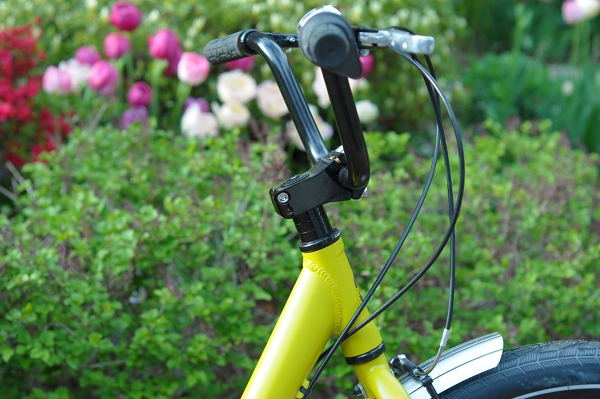


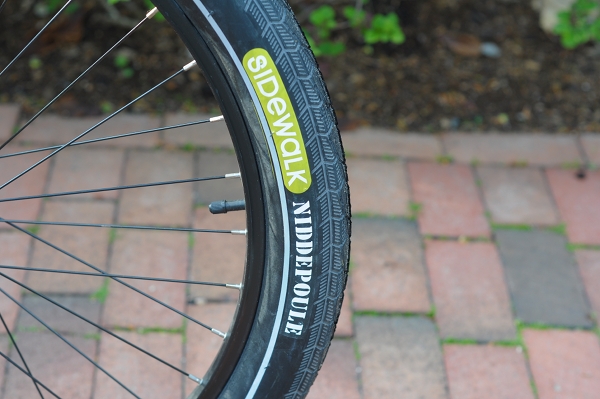

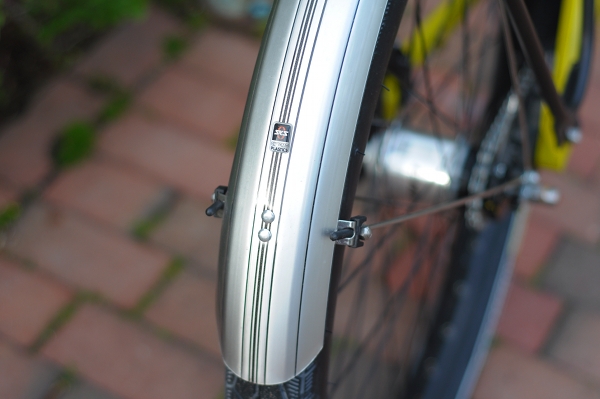
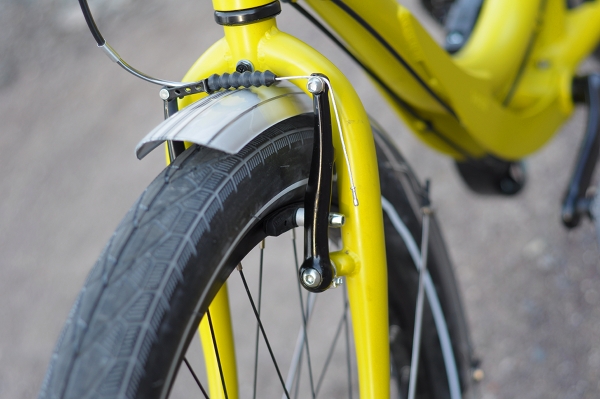
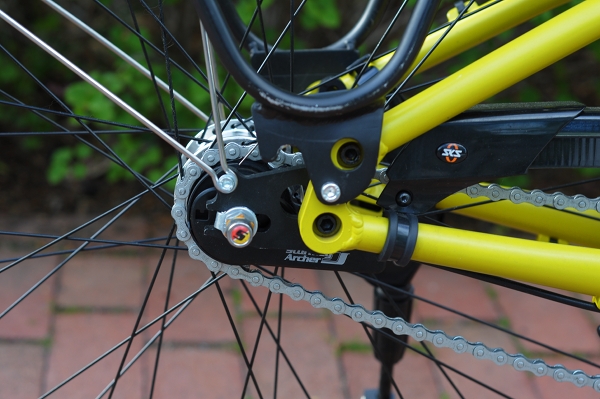
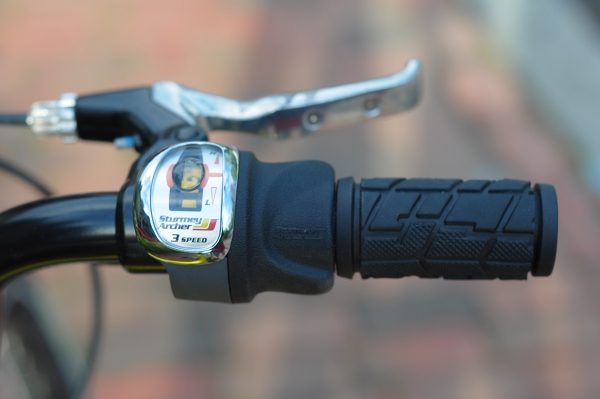
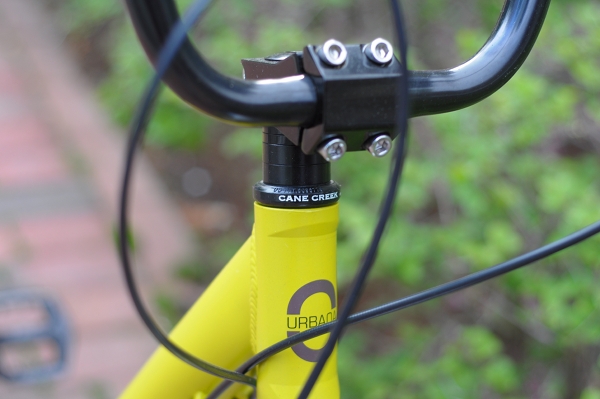

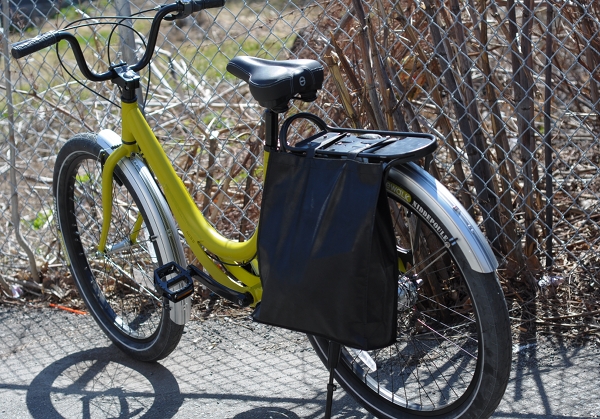
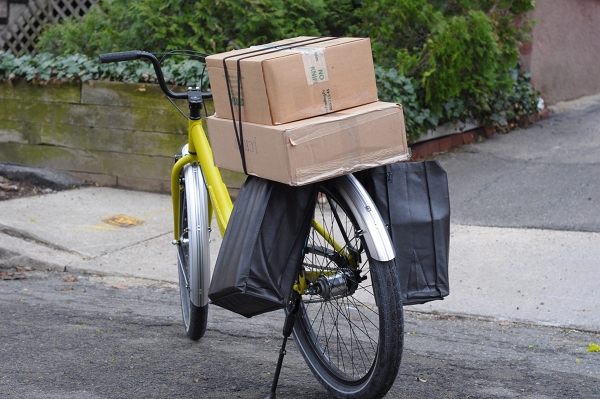
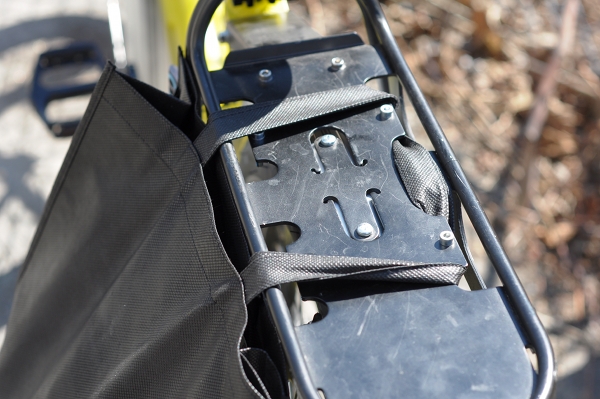
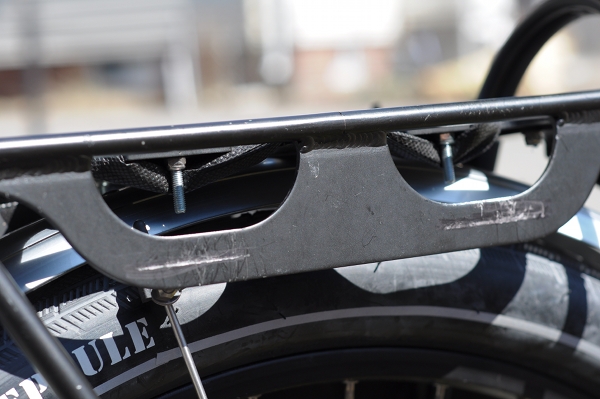
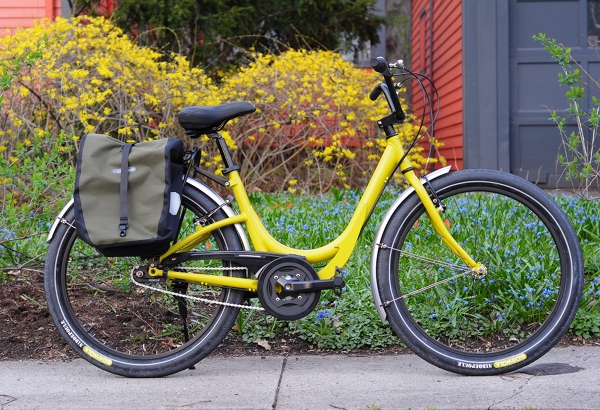


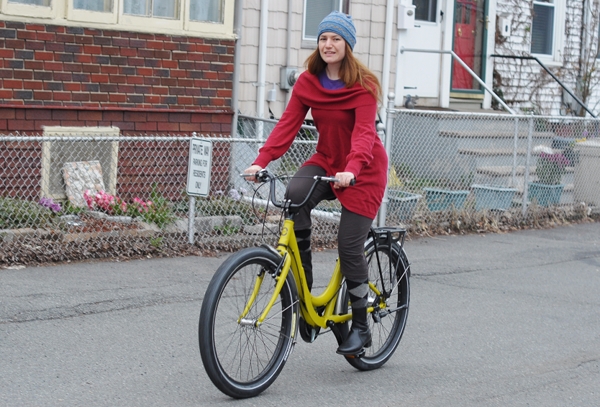
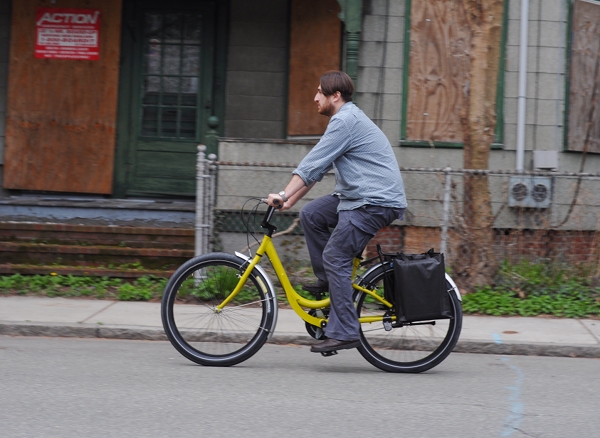
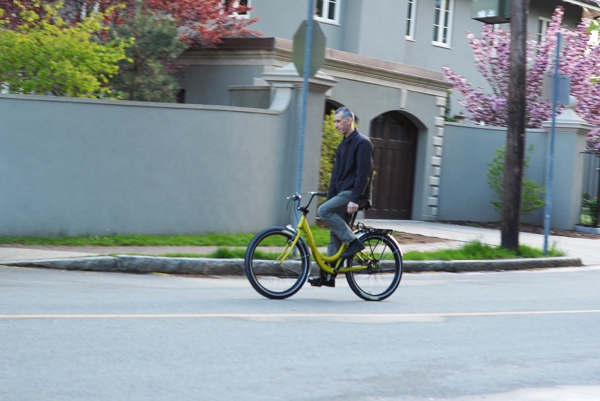
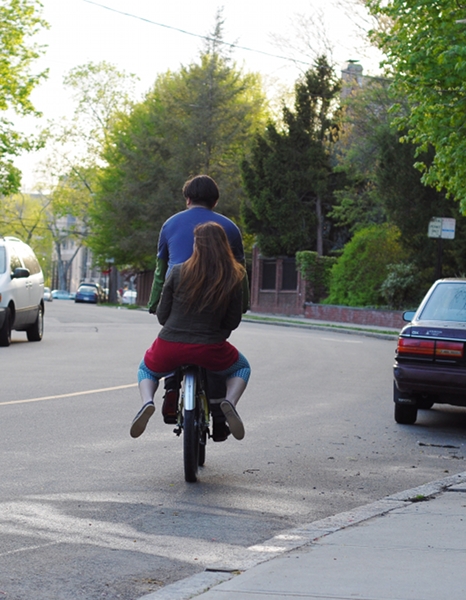
Given your verdict, maybe you really should consider this: http://www.finnishdesignshop.com/outdoor-bicycles-jopo-bicycle-orange-p-4470.html
ReplyDeleteThe only differences are the Jopo is cheaper, comes in lots of pretty colors, and is single speed with only coaster brakes, but the experience is very similar! It's absolutely the go-to in-town bike for errands and causes me to aim for the potholes because they're fun. :)
Jeez this review os full of typos and grammatical errors, but I have to run. Please forgive me, I will correct it all later : )
ReplyDeleteI find riding sideways is a much more comfortable way to ride pillion.
ReplyDeleteThe trick is to walk/ jog a step or two as the rider starts moving and then sit down sideways on the rack. It sounds and looks hard, but is surprisingly simple once you try it :)
oh, and the bike- I kind of like the color, but I kind of agree that it's awkwardly positioned for the US market.
The Urbana looks like a terribly fun bicycle. It seems from your review that it would actually be a good bicycle for the area I'm in. I'd love to try one out someday.
ReplyDeleteI was going to mention that curiosity is typically "piqued" not "peaked".
ReplyDeleteHave you tried sitting sidesaddle on the rack? I regularly chauffeur people on my Dutch bike on long rides (up to 10 miles at a time!!) and found this to be the best way: it always you to move around, hop off at anytime, and enjoy the view.
ReplyDeleteThe truly Bad-ass don't sweat punchation and speling.
ReplyDeleteSpindizzy
Nice writeup for a bike that was initially panned as an ugly duckling but evolved into a swan. I like that rear rack. May even try to modify my rack to accommodate grocery bags.
ReplyDeleteGreat review! I appreciate that you took the risk and gave your readers an honest review of a bicycle slightly out of the "norm" relative to the style of bicycle you would ordinarily review. I think BMX and Mountain Bike cyclists looking for an urban style bicyle would find this bike an interesting option, which would still capture the lure of the cycling their normally used to. As well as giving an alternative to those who feel they need a robust fat tire urban city bike, with racks and fenders, in order to do errands yet feel comfortable and secure. It's definitely a different style of lovely bicycle, but lovely all the same.
ReplyDeletecycler - I've heard that before -- about getting on once the bike gets moving -- but I never really bought it. I prefer my passengers to get comfortable before we move off. And my Oma is a single-speed.
ReplyDeleteHello, I agree with the practical use of the "U" winding frame.
ReplyDeleteI prefer to ride this way to side-saddle, don't know why. Maybe it makes me imagine I am on the back of a motorcycle.
ReplyDeleteThank you for the helpful emails pointing out my spelling errors - I guess I'll go take care of those now : )
Damn, people are holding you to a NYT-level of editorial standard, evidently, so I thought I’d comment on the content.
ReplyDeleteGreat review, even though your badass quotient just took a hit. That reminds me: the dropouts are replaceable; maybe for crashability and/or the ability to easily swap out IGHs or derailleurs.
Re: pillion. Really don’t. I shudder at the thought of another Anatomical Article. “When my shizit gets stuck in the rat trap…”
Re: motorcycle. Parallel universe moto blog?
There are a lot of things I like about this bike: step-through, compact frame with weight distributed like a downhill bike, massively overbuilt efficient alu frame necessitating huge tires, nicely-designed rack, bmx-type platform pedals with metal pins. Initially I didn’t like the spec of the bmx bars, but realized there are plenty of aftermarket ones with various degrees of sweep that are inexpensive and easy to swap. The fore/aft adjustability of the bars combined with the slack head tube and raked-out fork is going to do a lot for comfort but also positions most riders between the axles as opposed to being too far out over the front.
I understand start-up tooling costs are very expensive and this bike’s pricing reflects that as does the unifit sizing. I wish Jerome success and, if he’s reading this, will take the following in this spirit.
This bike is way too expensive for something that doesn’t fit someone precisely. The replaceable dropout is fine theoretically, but mounting the rack to the frame puts the front rack fence too far forward. Combined with a petite rider, a pretty slack seat angle and coiled saddle springs, not to mention the rider’s ass, the useable platform space is greatly reduced. Mounting it on the seat stay is stronger, no doubt, but necessitated by the replaceable d/o. A standard configuration here would mean the rack would be mountable further back w/o compromising strength.
I get the short chain stays make the bike snappier and theoretically more efficient, but since so much thought was put into the rack design it only makes sense to maximize its usefulness by lengthening the chain stays to accommodate truly huge Dutch-type panniers if necessary. With a longer rack I can easily see this bike hauling a kid or two plus bags.
The tires are probably good quality and roll decently and no doubt there is a keep-it-local sentiment in spec-ing the Niddepoules, however the maximum inflation capacity of 40 psi just seems too low for any trip beyond a few miles. The largest Fat Franks, for comparison, take 60 psi; the extra 20 psi goes a long way to make the ride more efficient and extending its range, though I’m sure with this frame the ride is much harsher as well. Again, it’s a very expensive bike to be limited to only errand running. Of course, running pressures in the 20s would make it trailable, but the geo would get in the way for it to climb ok. Compromises.
Speaking of which, such a slack seat angle would not work for me and running my seat super far forward on the rails is just wrong. A more moderate angle with a seatpost with a large range of setback adjustability would make the bike fit the same without introducing a lot of dork look. I’m just noticing the BB is set forward of the ST, so when I say seat angle that’s not correct. More like relative seat placement.
Anyway, a potentially great bike w/some flaws, from a guy who hasn’t ridden one. Yeah, call me a hypocrite.
"Re: pillion. Really don’t. I shudder at the thought of another Anatomical Article. “When my shizit gets stuck in the rat trap…"
ReplyDeleteI'm sorry, but I'm not sure what point you're trying to make here. Care to explain?
Very nice review! I'm glad you like it. It is good to be able to get out of your "comfort zone" and enjoy something you might otherwise have missed out on. I like it too!
ReplyDeleteNina - How wide are the tires on that bike? Based on the pictures I don't see how the handling (and load capacity) could be similar, but you never know.
ReplyDeleteSpindizzy - Alas, I am no longer all that bad-ass : (( Youth has faded.
Sue - I think your assessment is spot on. For that reason, I also think that Urbana is mis-marketing the bike somewhat. It has the potential to become a cult classic, but they need to market it to the right demographic.
Jenrik - I was directing my jokey comment at V, who had written an encyclopedic article on women's issues, if you catch my drift.
ReplyDeletePersonally I've ridden sidesaddle and like it much better than straight ahead if the pilot knows what he's doing. In the puritanical US, tho, it ain't actually socially acceptable. Now, where's my skirt...
"I shudder at the thought of another Anatomical Article. “When my shizit gets stuck in the rat trap…”
ReplyDelete: )) I don't think I own any body parts that could get stuck in the rat trap under those circumstances, but I wonder whether this happens to men in NL! Thanks for the great article idea.
I agree w/Sue except for this: "I think BMX and Mountain Bike cyclists looking for an urban style bicyle would find this bike an interesting option, which would still capture the lure of the cycling their normally used to."
ReplyDeleteBMX and mtb are a rather testosterone-driven subspecies so anything with a step-through is seen as emasculating. You might as well paint flowers all over it. AGEING BMXers and mtbers with bad hips or backs don't have an issue w/it per se. Anything to get the leg to the other side.
"weight distributed like a downhill bike"
ReplyDeleteWhat does that mean? I am totally unfamiliar with MTB geometry, especially downhill.
BTW: Based on my description, do you all think this would make a good winter bike? Compared to, say, the Surly Pugsley? Manufacturer has all sorts of pictures of people riding in snow, but that doesn't necessarily mean yes.
Velouria said...
ReplyDelete"I shudder at the thought of another Anatomical Article. “When my shizit gets stuck in the rat trap…”
: )) I don't think I own any body parts that could get stuck in the rat trap under those circumstances, but I wonder whether this happens to men in NL! Thanks for the great article idea.
I'm waiting with baited breath!
It means the mass is centered really low. See the bottom bracket where there's a yoke from which it hangs and the massive bottom of the U and where the seat tube ends? That's where most of the frame's weight is centered. See how the seat stays are kind of low? That contributes to this.
ReplyDeleteWhat Jerome's done is take the top tube away from a downhill bike and reinforced the other bits. Smart.
re: winter bike. This is a very slippery (sic) slope, because it mostly depends on snow conditions and available traction. In deeper, softer stuff often times a slimmer wheel/tire combo will slice through to give you a good purchase, but it depends on what's underneath. The Really Fat Tire has the advantage of floating over stuff so the snow can be deeper. I haven't ridden a RFT in these conditions so I can't say. That Eskimo thing where there's a million words for snow is applicable here: it's too variable to say for sure.
Yay, the big review! I've been interested in this bike since I first saw it here. I thought it looked like the kind of bike that would power through potholes, and I was right! And since I don't have a car, and also don't like going to the supermarket 2-3 times a week, the ginormous carrying capacity would be amazing. I even kind of like the yellow color (although I'd really prefer red or silver first). Unfortunately, that is WAY too much money IMO. Maybe I'd be interested at $600, MAYBE.
ReplyDeleteAlthough the idea of getting my husband in my "bitch seat" is very tempting... :)
I've ridden a fair bit in the snow/blizzard conditions and really regret the Urbana bike arrived to us after winter was (finally!) over. It would be quite interesting to compare this to my Pashley head-to-head.
ReplyDeleteIf the conditions are freezing, ice quickly begins to form all over the rim. My Pashley with hub brakes is not affected and I often arrive to my destination with 1/4 of the outer wheel covered in ice/sludge. On the other hand, V brakes are so strong. And yet on the third hand, you really don't need to brake cycling in a blizzard. We'll just never know.
Erica - For me $800 would be reasonable.
ReplyDeleteHowever, when I consider that bikes like the Civia Loring cost over $1,000, I'd rather have the Urbana for sure.
Slush, ice and water affect braking on rims, but a periodic "bleed" of the moisture keeps the rim useable. A light squeeze will kind of squeegee stuff off. If it's solid ice frozen on because the bike has been left outside, all bets are off. With slush often there's a lot of grit, which will do wonders for wearing your pads and rims.
ReplyDeleteI rode the Loring and was surprised how much I liked it w/o load. Being a QBP product it has the potential to come in at a low price point, but their mktg. dept. decided to gussy it up w/discs, bamboo, racks and Brooks, no doubt determining these were selling points and it pushed the price north. I had a long conversation with the bike shop owner and she confirmed when it comes to this level of utility people are after some of these bling bits and not so much a super useful, less prettified bike, one of which was sitting, forlon, in the corner.
Looks pretty awesome to me. I think that bright yellow color is cool too, although I agree ... black would give it more of an old-school appeal. Thanks for the review.
ReplyDeleteThe beauty of any machine comes first and foremost from the way it fulfills its function elegantly and efficiently, and in that sense this is quite a "lovely" bicycle, even if it is a bit different from some of the classic beauties so often featured here.
ReplyDeleteI do agree the price seems a bit high, but hopefully they'll find themselves a niche.
Ground Round Jim said...
ReplyDelete"Slush, ice and water affect braking on rims, but a periodic "bleed" of the moisture keeps the rim useable. A light squeeze will kind of squeegee stuff off. If"
I got snow on the front rim of my Bella Ciao bike (after cycling through snow), which has a front caliper brake. No squeezing helped; the front brake was pretty much non-functional after that. Thankfully still had the rear coaster brake.
Well, did you squeeze really, really, really hard? You have to squeeze so hard as to create fire, which will melt the snow...
ReplyDeleteSqueegeeing helps, but Mother Nature is a bitch. There are specific wet weather brake pads that help. Also I'm assuming the Bella has a long reach caliper, which definitely is way weaker than a V. For me there's no such thing as a brake that's too strong, but it has to be controllable.
If you find Vs too strong you can go cantis. Oddly enough, I think you know someone to switch with. You can put a canti on the front, V on the back. Go nuts.
So, to summarize: high performance brakes in inclement conditions include: Vs, discs, and good roller/hub/internals. The front brake on the fr8 is really strong, for instance.
re: fat tire snow bike. If you want to just test how it works you could get out your old mtb and put some Fat Franks on next winter. It should have lots of clearance for them. Otherwise old mtbs are a dime a dozen.
This reminds me: since you seem to be adept w/a diamond frame, why do you still prefer the step-through?
"BMX and mtb are a rather testosterone-driven subspecies so anything with a step-through is seen as emasculating. You might as well paint flowers all over it. AGEING BMXers and mtbers with bad hips or backs don't have an issue w/it per se. Anything to get the leg to the other side."
ReplyDeleteLOL
"Personally I've ridden sidesaddle and like it much better than straight ahead if the pilot knows what he's doing. In the puritanical US, tho, it ain't actually socially acceptable. Now, where's my skirt..."
Hah! Are you saying riding passenger on a bike ain't socially acceptable, or just riding sidesaddle? Otherwise I agree, sidesaddle uber alles!
You guys look sooo cute when you're on the back!
ReplyDeleteBMX is one of the few areas in cycling in which I've never participated. And I've done downhill MTB, but I've never owned a downhill (or, as Peter White calls them, "invalid") bike. So I really can't say much about how those bikes are designed. However, they are both made to take hops and jumps, and generally getting banged around. So they are probably good starting points, along with Dutch city bikes, for the Urbana.
I'd be curious to try the bike to see which type of bike it most resembles.
Ground Round Jim: A loop, ladies or mixte frame is still much easier to ride for anyone riding skirts, kilts or long coats or jackets. For the first thirty-five years or so I cycled, I rode nothing but diamond or "men's" frames. However, now that I ride to work in skirts, and like to ride to outings of one kind and another, I find dropped frames handy. Even those who would never dream of wearing anything but pants could find "dropped" designs useful if they frequently mount or dismount loaded bikes.
Jenrik, some of the BMX and MTB "ladies" that I know would disagree ;)
ReplyDeleteGR Jim - I am fine riding diamond frames and prefer them for roadbikes (i.e. I would not want a mixte roadbike). But for transportation the step-through is essential, because (1)I ride in skirts a lot, and (2) I fond step-throughs easier for getting on and off the bike frequently. So one reason I'd prefer to rig up the Urbana as a cargo bike than to use, say, a standard long tail cargo bike or front-load bike, is because of the low step-through. ANT made a loop frame basket bike some time ago that I think would be great too.
ReplyDeleteExcellent review; i think the bike seems like a good one, but not at that price point.
ReplyDeleteNow, maybe it's b/c i actually ride lots of different types of bikes, but i'm not seeing the bmx or mountainbike connections on this thing. Those are not BMX bars, that's not a bmx stem, and the geo doesn't seem much like a mtb. The bars are more like mini-apes, the stem is short/stumpy like a bmx stem, but the face plate faces forward rather than up or down, and i'd be very surprised if the bar/stem interface is a 7/8". Looks to be a 1" (25.4mm) to me, which is good news b/c it'd make switching to other kinds of bars easier. Geometry-wise, i suppose there are some similarities to some downhill bikes, but it's a far cry from the classic NORBA geometry. The headtube angle is slack, as is the headtube angle of a downhill bike, but it seems far more slack to my eye than any downhill bike i've seen. Perhaps that's due to the rigid fork,as opposed to the 8"+ travel front suspension seen on most DH bikes. I guess it might seem to have some level of BMX/mtb influences to someone who doesn't ride those disciplines (and yes, i do realize that the designer has some MTB roots), but i don't think this would appeal to the mtb/BMX set any more than other cruiser/hybrid type bikes would.
What is the urbana? I'd classify it as an urban/town bike, possibly a cargo bike (nicely designed rack), absolutely a neo-balloon tire cruiser. I think it's pretty cool, but it'd be cooler to buy the rack a la carte and mount it on something else.
Very nice review, overall. I just feel the references to BMX and mtb are kind of misleading.
-rob
ps- +1 to what Sue said. Why place gender bias on a sport or passtime?
Rob - Interesting comments re the MTB and BMX. I include the references because (1) this is how the manufacturer describes the bike, (2) this is how others have described the bike, and (3) it feels like a MTB to ride - not like a normal city bike. Because of that last reason, it totally makes sense to me that the geo is MTB-informed.
ReplyDeleteI could probably remediate a Kona Africa Bike Three or even a Kona Bike for $300 on top of the Kona $479 MSRP and get a better user-experience and tco as compared to the Urbana. Even Civia's der Halstead (an ugly bike) beats the Urbana price. Sorry.
ReplyDeleteThis bike isn't genre-specific, so any kind of label you put on it can be argued. It def has strong mtb and bmx influences, though. A common bone of contention in the comments section is what genre a specific bike falls into. There's so much crossover in the industry now that many bikes are hard to categorize, like this one. The categories tend to reflect what has been the standard in it and how it's marketed. Best just to judge the bike on what it can and can't do.
ReplyDeleteAs far as head tube angle downhill bikes are running around 64 degrees now; any slacker and it'd be horizontal.
V - Imagine my surprise when the link to the ANT turned out to be a picture of you. I should say imagine your surprise, judging from the pic.
Sue - In my haste I wasn't thinking about the ladies who ride bmx & mtb, even though I have friends who ride mtb. My bad there; my statement referred to the dudes I know.
Justine - I know the Merits of the Step-Through; I was asking V what her individual take on it is.
Anon - Will the Kona Africa accept 2.6" wide tires?
ReplyDeleteOops, wrong link to the ANT Basket Bike in my earlier comment! Here is the correct link.
ReplyDelete"Velouria said...
ReplyDeleteAnon - Will the Kona Africa accept 2.6" wide tires?
May 7, 2011 4:38 PM "
I don't know, and it's not clear to me that it matters (sheer tire width at the extremes, that is, except as marketing device). Tell me more, ask me more.
Hmm. Well, to me it matters. Read my descriptions of this bicycle's ability to swallow potholes and obstacles in the road. I cannot tolerate a harsh ride on a transportation bike; it's painful and unpleasant - so the cushier the tire, the better. Others' preferences may vary.
ReplyDeleteI've never tried a Kona Africa, but I see some of them around the neighbourhood now, so some local store must sell them. I'll make it a point to have a look, because they look good. My current favourite budget bike is the KHS Manhattan Green - and my only complaint about it, is that it is harsh over potholes and cobblestones.
It's interesting comparing the Loop Basket to the current Mixte Basket.
ReplyDeleteI hear you on loops, they're great. The inherent problem with a loop utility bike for carrying heavier loads is its structure. Lighter loads are fine. In comparing the two the LB has thinner tubing on the rear rack than the MB, perhaps coincidentally but infers the LB twists too much if you put heavy loads fore and aft. The MB solves this problem with a couple of stays that run from the HT to the dropout. The MB also has that Workcycles seat tube design, the LB doesn't.
re: fat tires. A well-designed fat tire rolls very well in the upper ranges of their recommended inflation pressure. You don't put these on a race bike though. Their application on an errand bike is ideal, useable on a medium-commuter.
A bunch of us rode the mixte basket bike at the NE Bicycle Expo today. I have pictures and will write about it in a couple of weeks (don't want to give everyone an ANT overdose after the Truss Frame post earlier). You're right about the loop basket bike being rated for less weight... but (at the risk of being accused of sexism) I think that on average, yadda-yadda-yadda, the same contigent who will want a loop frame is also likely to carry a bit less weight on the bike.
ReplyDeleteYes. It goes to rider confidence & strength, regardless of gender.
ReplyDeleteHello, Jerome of Urbana here, just a few comments on the step through and the fat tires.
ReplyDeleteStep through are especially usefull with a big baby seat. And speaking of baby, I think they need the shock absortion of the big tires.
What is good about the big tires on the Urbana is that you can fit them with fenders with plenty of clearence. If you want 1.75 instead... they fit too!
Sticky snow and fenders require lots of room around tires.
I think that those who haven't tried fat tires - Fat Franks, Big Apples, Grand Bois Hetres, the Urbana's tires and similar - simply don't understand how much more comfortable and stable they make a bicycle. It's not something we can argue academically; just give them a try and see whether you still think it's a gimmick.
ReplyDeleteThank you for the nice review!
ReplyDeleteNext time I'll send Lovely bike my 6 in. travel dual baby seat trail bike, along with a bottle of hydraulic oil, in case something goes wrong with the shocks or brakes :)
Schwalbe has had rolling resistance tests done at Kòln University. The big tires had less friction! It gets very obvious on gravel roads.
ReplyDeleteWow
ReplyDeleteGreat review. Interesting comments.
My question is how much of the ride is the tires and just the tires? This demands serious experimentation. Mount those tires on something else & then try some more. I nominate Velouria for the job because if she doesn't I will have to do it myself.
Whenever I switch a bike to widest feasible tires I like it more. Have only done one too-short testride on a Pugsley - an experience that makes everyone laugh and grin. Pugsley sadly is not for everyone.
Besides width its also rolling diameter. Those 26" wheels with 2.6 end up as tall as most 700 wheels.
This is why I keep reading here. Thank you.
Anon - I think the comfort aspect of the bike is def due to the tires. But the load capacity and the heavy-duty stiffness of the frame are another matter.
ReplyDeleteWhat did you not like about the Pugsley?
I like that you gave the "Friendly forest troll" a chance :)
ReplyDeleteScreech, that stem looks like a Dimension BMX stem to me. Back in the 80s "top-loader" stems were the thing, but today "front-loaders" are at least as common.
ReplyDeleteV. mentioned not getting wet despite the Urbana's shortish fenders. Maybe those tires shed water similarly to the Big Apples.
ReplyDeleteNot only are my "narrow" 50mm ones wonderfully cushy, when ridden through puddles at speed, instead of throwing spray everywhere, all the water drops off the tires just above ground level.
And yeah, I've got the fenders and long mudflaps, but the spray never gets high enough to hit the mudflap. Amazing.
More on wide tires: As if right on cue, there is a review of two Linus bikes and a Fat Frank Viva on RideBlog today. She got on the Viva and loved the wide tires immediately.
ReplyDeleteJerome - Jan Heine of Bicycle Quarterly also has a lot to say on the superior rolling resistance of wide tires, in his case 650B.
Velouria @ 10:18
ReplyDeleteNothing about the Pugsley I did not like. Fact remains owning one of those is a commitment. Not cheap. Special parts. The huge tires are enormously fun. They are just not necessary.
Nid de Poule tires are not available w/o the bike. Hope they fix that. I'm on the lookout for something that would take the 622-60 Big Apples. My 622-50s are fun past what I ever expected. They take all the room I've got. But darn it, I can't afford to commission a custom for the 60s and there isn't that much that wd do it except 29er MTBs.
Velouria - I just saw your jopo questions. I've never had specs on this bike and know very little about it except how it feels to ride it. I can say it has a large and sturdy rack. I keep a milk crate on it and wouldn't hesitate to load it up with the heaviest cargo. I wouldn't carry a person on it, but I think the limiting factor there is the small wheels that would make it less than fun for the passenger. I'm not sure it really would carry that load anyway though.
ReplyDeleteAs for the tires, well, they're about as wide as my pinky is long. They're not fat franks, but they do bounce right over the potholes.
Reviewers of the Urbana tend to delight in how easy and fun it is to hop curbs with the tires, and of course there is that. But I feel like stressing this aspect almost trivialises them. The tires are genuinely useful on bad roads.
ReplyDelete